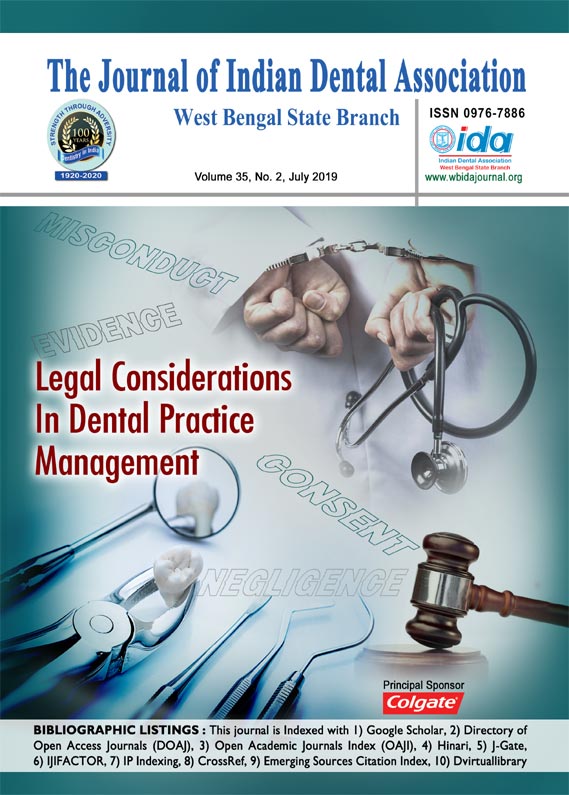Upcoming Events
1. Article Title.
2. Author Details.
3. Abstract.
4. Keywords.
5. Corresponding Author details.
July 2019
Volume : 35
No.: 2

Dr. Swagata Das,Dr. Dibyatanu Majumdar,Dr. Surjargha Mukherjee,Dr. T.K. Giri,Dr. Sugata Mukherjee
Abstract: A plethora of confusions and queries lies regarding the association of TMD and CSD due to the fact that there is a frequent overlapping of the symptoms associated. It is although unknown whether a true association exists between TMD and CSD. Many studies have been conducted to search for the existence of a causal relationship between these two disorders or whether any one of them acts as a predisposing or a precipitating factor for the other, whether there is any specific mechanism that can be attributed to the concurrent development of clinical symptoms of TMD in Cervical spinal disorder patients and vice versa. A systematic search was executed through the open web and articles relevant were reviewed. The purpose of this systematic review is to evaluate whether there is any true association present between TMD and CSD and whether the presence of CSD in patients predisposes to the development of TMD.
Dr. Abhisek Chowdhury,Dr. Seema Rathi,Dr. Sanjay Prasad,Dr. T.K. Giri,Dr. Surjargha Mukherjee,Dr. Sugata Mukherjee,Dr. Suman Chakraborty
Abstract: Achieving and maintaining implant stability is crucial for implant survival and successful osseointegration. Absence of micro-motions is the most critical factor for successful osseointegration. Implant stability in term of bone to implant contact is determined at two stages – PRIMARY AND SECONDARY. Primary stability comes from mechanical engagement of cortical bone while secondary stability develops following regeneration & remodeling of soft and hard tissue around implant after insertion. So, it is of utmost important to evaluate implant stability at various time points to predict prognosis for successful therapy. The aim of this article is to highlight various methods available to determine implant stability.
Dr. Shubhabrata Roy,Dr. Ankita Tamta,Dr. Samiran Das,Dr. Soumitra Ghosh,Dr. Preeti Goel,Dr. Sayan Majumdar
Abstract: An ocular defect not only affects a person's vision, but also causes severe psychological trauma. An ocular prosthesis improves appearance, increases confidence and enhances social acceptance. But stock eyes are not satisfactory in most situations. A custom made ocular prosthesis provides better adaptation, aesthetics and comfort than a stock one. Polymethyl methacrylate (PMMA) is most commonly used material for ocular prosthesis. Two patients with different ocular defects were treated with acrylic customized ocular prosthesis to provide better quality of life.
Dr. Subhasish Burman,Prof. Dr. S.K. Majumdar,Dr. Aritra Chatterjee,Dr. Soumen Mondal,Dr. Chandan Sahana,Dr. Mohsina Hussain
Abstract: Aesthetic closure of defects of the buccal commissure, after ablative surgeries is a daunting task for Oral and Maxillofacial Surgeons. The double rhomboidal flap is often used as a reconstructive option in such cases owing to its simplicity and association with fewer number of complications. We describe a case of a 60 year old male patient who presented with a histologically proven verrucous carcinoma of the left buccal mucosa, extending to the left oral commissure. Wide local excision with adequate safe margins of the lesion was done and the resulting surgical defect was closed using an ipsilateral double opposing rhomboidal flap. The final outcome was satisfactory in terms of both aesthetics and preservation of function.
Dr. Debasis Mitra,Dr. Aakansha Malawat,Dr. Subhapriya Mandal,Dr. Abhijit Das,Prof. (Dr.) Himadri Chakrabarty,Dr. Abhijit Chakraborty
Abstract: Partial denudation of the root surface by apical displacement of the gingival tissues leads to gingival recession, which can lead to clinical problems such as, hypersensitivity, root caries, cervical root abrasions, difficult for plaque control and aesthetic concern. Recently, new techniques have been suggested for the surgical treatment of multiple adjacent recession type defects. The current case report introduces a novel minimally invasive approach applicable for both isolated recession defects as well as multiple defects in the maxillary anterior regions. This case report describes the use of the Vestibular Incision Sub Periosteal Tunnel Access (VISTA) technique in combination with Connective Tissue Graft (CTG) in the treatment of gingival recession defects. Conclusion: The use of CTG along with VISTA technique allows clinicians to successfully treat multiple gingival recession defects.
Dr. Subhapriya Mandal,Dr. Debasis Mitra,Dr. Abhijit Das,Prof. (Dr.) Himadri Chakrabarty,Prof. (Dr.) Abhijit Chakraborty
Abstract: Gingival recession presents as a common condition in periodontal patients which can cause major functional and aesthetic problems. A variety of surgical procedures have been described for root coverage. The Pinhole Surgical Technique introduced by John C. Chao requires a minimal horizontal incision of 2-3 mm in the alveolar mucosa near the base of the vestibule. This case report presents a 50-year-old male patient having Miller's Class I gingival recession in the maxillary right central incisor, lateral incisor and canine. Pinhole surgical technique was used to prepare the recipient site by raising full-thickness flap through the horizontal incision near the base of vestibule. Connective tissue graft was harvested from palate. The graft was placed at the recipient site and stabilized with holding sutures. Three months' follow-up shows proper healing and adequate root coverage in the defect area. Pinhole surgical in adjunct to CTG may serve as a good alternative to conventional coronally advanced flap procedures.
Dr. Chitradeep Chakraborty,Prof. (Dr.) Anjana Mazumdar,Dr. Sandip Ghose
Abstract: Angiomyxomas are a group of relatively uncommon myxoid mesenchymal tumours associated with a high risk of local recurrence without any metastatic potential. The angiomyxomas are rarely reported in the head and neck region. This paper entails a case of deep aggressive angiomyxoma presenting as a huge unusual growth in the left side of the face, originating from buccal mucosa, reported to be present for about 15 years, which was accurately identified but unfortunately the subject died before the surgical intervention. An attempt has been made to highlight the clinical and pathologic standout features of this tumour, so that it can be diagnosed and treated properly in future
Dr. Aindrila Ghosh,Dr. Paridhee Jalan,Prof. (Dr.) Shabnam Zahir,Prof. (Dr.) Gautam Kumar Kundu
Abstract: The restoration of carious, fractured or discolored anterior teeth in children is a matter of extreme satisfaction to Pedodontists because this improves the dental esthetics and self confidence in a growing child to a great extent. At present there are several options available for the anterior esthetic and functional rehabilitation but the success mainly depends on several factors like the case selection, motivation of the parents and the behaviour of the child in the dental clinic. Sometimes it can be challenging for the Pedodontists to perform intricate and lengthy procedures in young uncooperative children. This case report describes the esthetic and functional rehabilitation in a 4 year old uncooperative child using the newly introduced fibreglass Figaro crowns.












